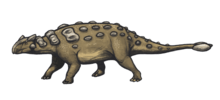Liaoningosaurus
| Liaoningosaurus Temporal range: Early Cretaceous, 122 Ma | |
|---|---|
| Scientific classification | |
| Kingdom: | Animalia |
| Phylum: | Chordata |
| Clade: | Dinosauria |
| Order: | †Ornithischia |
| Suborder: | †Ankylosauria |
| Family: | †Ankylosauridae |
| Genus: | †Liaoningosaurus Xu, Wang & You, 2001 |
| Species: | †L. paradoxus |
| Binomial name | |
| Liaoningosaurus paradoxus Xu, Wang & You, 2001 | |
Liaoningosaurus is an unusual genus of ankylosaurian dinosaurs from the early Cretaceous period of China. It contains a single species, Liaoningosaurus paradoxus, and is represented by two fossil specimens collected from the Yixian Formation (Aptian age) of Liaoning Province. L. paradoxus was unusual among ornithischian dinosaurs in that it is known to have hunted or scavenged, with preserved gut contents showing that it ate fish. Additionally, some features of its skeleton may suggest that it was partially aquatic.[1]
The type species L. paradoxus was named by Xu Xing, Wang Xiaolin and You Hailu in 2001. The generic name refers to Liaoning. The specific name refers to the confusing mix of nodosaurid and ankylosaurid features shown by the specimen.
Description
The holotype IVPP V12560 (Institute of Vertebrate Paleontology and Paleoanthropology, Beijing) is an articulated skeleton measuring approximately 34 centimetres (13 in) in length. The specimen is unique among all known ankylosaur fossils in the retention of the external mandibular fenestra. Antorbital fenestrae may also be present. It has relatively large teeth, including teeth in the praemaxilla ( primitive or possibly juvenile trait). The points on the tooth crown were unusually long and sharp, giving each tooth a fork-like shape. It had long feet, long lower legs, and long, sharp claws on the hands and feet, unlike the blunt claws of other ankylosaurians. All of these were initially interpreted as juvenile features, given the specimen's small size and lack of fusion between the spine and hip bones.[2] However, information from a second specimen has led some scientists to conclude that the lack of hip fusion and long limbs and toes are in fact adaptations to an aquatic lifestyle. The large, fork-like teeth and sharp claws may have been adapted to catch fish and other small animals. Stomach contents recovered with the second L. paradoxus specimen show that fish formed part of the animal's diet.[1] This indicates that Liaoningosaurus was either carnivorous or at least omnivorous, making it the first ornithischian known to science to have adapted to such a lifestyle.[3]
Another supposedly unique feature originally identified from the type specimen was the presence of armor plating on the belly. A large segment of what appeared to be the bone from a flat osteoderm covered the underside of the abdomen. This had a surface structure covered with small hexagonal and rhombic bumps. Such plates had never been found with other ankylosaurians, and it has been suggested that, if L. paradoxus was indeed aquatic, the belly plates may have protected it from predators attacking from below, as in modern turtles.[1] Smaller triangular osteoderms were found on the shoulder, including a small shoulder spike.[2] However, closer examination of the bumps seemed to suggest that they were not sculpted onto a single piece of bone, but instead resembled normal dinosaurian scales. The broken edges of the supposed plates, when studied in 2013 by paleontologist Victoria Arbour and colleagues, did not reveal any internal structure as would be expected from a piece of bone. Arbour and colleagues concluded that the "belly plates" were likely to be pieces of preserved skin.[4]
Relationships
Determining the relations of Liaoningosaurus is difficult because of the young age of the individual specimen and the presence of traits both typical of ankylosaurids and nodosaurids. Xu et al. published a cladistic analysis in 2001, placing Liaoningosaurus as an early branch within the Nodosauridae,[2] while Vickaryous et al. provisionally assigned it to the Ankylosauria incertae sedis in 2004.[5] A second cladistic analysis performed by Thompson et al. in 2011 suggested that Liaoningosaurus is a very basal ankylosaurid.[6]
See also
References
- 1 2 3 Ji Q., Wu X., Cheng Y., Ten F., Wang X., and Ji Y. 2016. Fish-hunting ankylosaurs (Dinosauria, Ornithischia) from the Cretaceous of China. Journal of Geology, 40(2).
- 1 2 3 Xu X., Wang X.-L., and You H.-L. (2001). "A juvenile ankylosaur from China". Naturwissenschaften, 88(7): 297-300.
- ↑ http://www.eartharchives.org/articles/armored-dinosaur-was-a-fish-eating-turtle-mimic/
- ↑ Arbour, V. M., Burns, M. E., Bell, P. R., & Currie, P. J. (2014). Epidermal and dermal integumentary structures of ankylosaurian dinosaurs. Journal of Morphology, 275(1): 39-50. doi:10.1002/jmor.20194
- ↑ Vickaryous, Maryanska, and Weishampel (2004). "Ankylosauria". in The Dinosauria (2nd edition), Weishampel, D. B., Dodson, P., and Osmólska, H., editors. University of California Press.
- ↑ Richard S. Thompson; Jolyon C. Parish; Susannah C. R. Maidment; Paul M. Barrett (2011). "Phylogeny of the ankylosaurian dinosaurs (Ornithischia: Thyreophora)". Journal of Systematic Palaeontology. 10 (2): 301–312. doi:10.1080/14772019.2011.569091.

